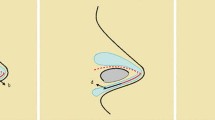Abstract
Background
Up to 25% of otoplasties can lead to complications, indicating the need for technical refinement. Stenström’s anterior auricular cartilage scoring is used in combination with Mustardé’s technique to treat the antihelix deformity in several series, with good results. Both can be performed with different instruments such as rasps or puncture needles.
Objectives
This study aims to compare the use of puncture needles and rasps for anterior cartilage scoring in otoplasty. The association of Stenström and Mustardé were the basic technique. Anatomical and aesthetic endpoints were assessed. We also reviewed postoperative complications.
Methods
Forty-two patients with prominent ears and no previous surgery were randomly assigned needle or rasps technique. They were operated on by the first-year plastic surgery resident in the years of 2014 and 2019. The patients were followed up and reviewed at days 2 and 15, as well as 1, 3 and 6 months postoperatively. The endpoints were evaluated through pre- and postoperative photographs by four experienced plastic surgeons unaware of the techniques used in each case. Patient satisfaction was searched by a “yes” or “no” question. Surgical time and postoperative edema were evaluated in 20 patients (2014 group).
Results
There were no statistical differences between the groups in terms of overall results, symmetry, antihelix shape or cartilage fracture. Ninety-five percent of the patients were satisfied with the outcome. The needle technique resulted in less postoperative edema and shorter surgical time.
Conclusion
Anterior cartilage scoring used in combination with posterior mattress sutures to treat poorly formed antihelical fold has good and similar results when performed with rasps or puncture needles, even in unexperienced hands. The needle has the advantage of leading to a comparable surgical time and less postoperative edema, while not requiring any special surgical instrument.
Level of Evidence IV
This journal requires that authors assign a level of evidence to each article. For a full description of these evidence-based medicine ratings, please refer to the table of contents or the online instructions to authors www.springer.com/00266.






Similar content being viewed by others
References
Mascio D, Castagnetti F, Baldassarre S (2004) Otoplasty: anterior abrasion of ear cartilage with dermabrader. Aesth Plast Surg 27:466–471
Caouette-Laberge L1, Guay N, Bortoluzzi P, Belleville C (2000) Anterior scoring technique and results in 500 cases. Plast Reconstr Surg. https://doi.org/10.1097/00006534-200002000-00004
Kaye BL (1973) A simplified method for correcting the prominent ear. PRS 52:184
Nevarre DR, Maloney C, Wolfort FG (2000) Endoscopic carpal tunnel release instruments used for auricular cartilage scoring and correcting a flattened antihelix. PRS 106:1214–1215
Mahler D (1986) The correction of the prominent ear. Aesthet Plast Surg 10:29–33
Bradbury ET, Hewison J, Timmons MJ (1992) Psychological and social outcome of prominent ear correction in children. Br J Plast Surg 45:97–100
Yugueros P, Friedland JA, Furnas DW (2001) Otoplasty: the experience of 100 consecutive patients. PRS 108:1052–1053
Luis Fernando Ungarelli(2012) Eficácia do retalho adipofascial retroauricular em otoplastia. Rev Bras Cir Plást 27(2) São Paulo
Stenström S (1963) A “natural” technique for correction of congenitally prominent ears. Plast Reconstr Surg 32:509
Gibson T, Davis W (1958) The distortion of autogenous cartilage grafts: its cause and prevention. Br J Plast Surg 10:257–274
Thomas SS, Fatah F (2001) Closed anterior scoring for prominent-ear correction revisited. Br J Plast Surg 54(7):581–587
Chongchet V (1963) A method of antihelix reconstruction. Br J Plast Surg 16:268–272
Miguel Marques Oliveira; Daniel de Sousa Marques Oliveira; Gustavo de Sousa Marques Oliveira (2013) Otoplastia estética com emprego de agulha de crochê. Rev Bras Cir Plást 28(2) São Paulo
Vecchione TR (1979) Needle scoring of the anterior surface of the cartilage in otoplasty. Plast Reconstr Surg 64(4):568
Bulstrode NW, Huang S, Martin DL (2003) Otoplasty by percutaneous anterior scoring. Another twist to the story: a longterm study of 114 patients. Br J Plast Surg 56:145–149
Stenström SJ, Heftner J (1978) The Stenström otoplasty. Clin Plast Surg 5:465–470
Mustardé JC (1963) The correction of prominent ear using simple matress sutures. Br J Plast Surg 16:170
Gantous A, Tasman A, Neves J (2018) Management of the Prominent Ear. Fac Plast Surg Clin North America 26(2):181–192
Smittenberg M, Marsman M, Veeger N, Moues C (2018) Comparison of Cartilage-Scoring and Cartilage-Sparing Otoplasty. Plast Reconstr Surg 141(4):500e–506e
Hafiz R, Philandrianos C, Casanova D, Chossegros C, Bertrand B (2016) Technical refinement of Stenström otoplasty procedure. Revue de Stomatologie, de Chirurgie Maxillo-faciale et de Chirurgie Orale 117(3):147–150
Mazeed AS, Bulstrode NW (2019) Refinements in otoplasty surgery: experience of 200 consecutive cases using cartilage-sparing technique. Plast Reconstr Surg 144(1):72–80
Webster GV (1969) The tail of the helix as a key to otoplasty. Plast Reconstr Surg 44:455
Author information
Authors and Affiliations
Corresponding author
Ethics declarations
Conflict of interest
The authors declare that they have no conflict of interest.
Informed Consent
All study participants gave written informed consent, institutional review board approval was granted, and the study was conducted following the provisions of the Declaration of Helsinki.
Additional information
Publisher's Note
Springer Nature remains neutral with regard to jurisdictional claims in published maps and institutional affiliations.
Electronic supplementary material
Below is the link to the electronic supplementary material.
Supplementary material 1 (MOV 160226 kb)
Rights and permissions
About this article
Cite this article
Zanin, E.M., Maximiliano, J., Oliveira, A.C.P. et al. Otoplasty: Rasps or Puncture Needles? A Clinical Trial. Aesth Plast Surg 45, 521–527 (2021). https://doi.org/10.1007/s00266-020-01972-z
Received:
Accepted:
Published:
Issue Date:
DOI: https://doi.org/10.1007/s00266-020-01972-z




